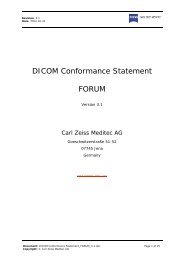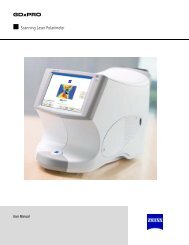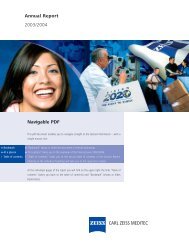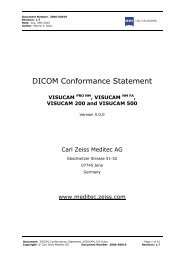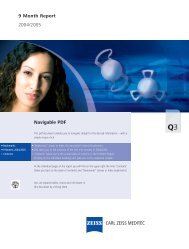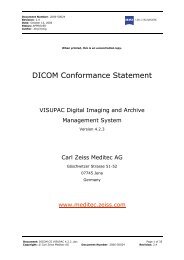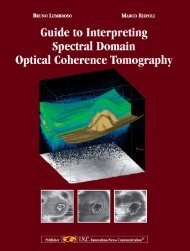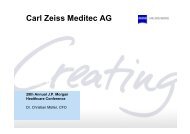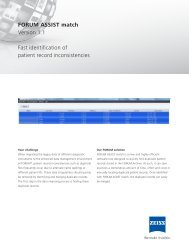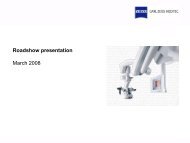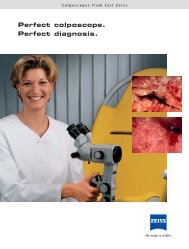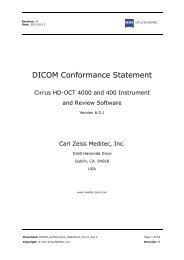Download - Carl Zeiss Meditec AG
Download - Carl Zeiss Meditec AG
Download - Carl Zeiss Meditec AG
Create successful ePaper yourself
Turn your PDF publications into a flip-book with our unique Google optimized e-Paper software.
ReLEx smile: Flapless. All-femto. Single-step.<br />
The Effects of Refractive<br />
Surgery on Dry Eye Syndrome<br />
and Corneal Sensation<br />
As a flapless and minimally invasive procedure, ReLEx smile has the potential to cause fewer<br />
dry eye symptoms compared with femtosecond LASIK.<br />
BY KIMIYA SHIMIZU, MD<br />
It is not uncommon for a<br />
patient to suffer from dry<br />
eye syndrome after refractive<br />
surgery. In many of<br />
these cases, however, the dry<br />
and itchy side effects result<br />
from the LASIK flap and not<br />
from the actual refractive<br />
treatment. In procedures<br />
that do not require a flap,<br />
such as <strong>Carl</strong> <strong>Zeiss</strong> <strong>Meditec</strong>’s<br />
ReLEx smile treatment, these<br />
symptoms are much less<br />
common. For this and many<br />
other reasons, ReLEx smile is<br />
now my procedure of choice<br />
for patients who desire<br />
refractive correction.<br />
SHIFTING OF MY<br />
SURGICAL PREFERENCES<br />
I started performing refractive surgery in Japan in the<br />
1990s. In the early part of the decade, I started performing<br />
PRK and radial keratotomy (RK) and, in 1997, I began<br />
to perform LASIK. I transitioned to LASIK because of the<br />
promise for better visual recovery and less pain, and I<br />
believed that it was a better procedure compared with<br />
surface ablation or RK. For the next 11 years, I performed<br />
LASIK in the majority of my patients and enjoyed excellent<br />
results and successful surgeries.<br />
In 2008, I stopped performing LASIK in favor of other<br />
procedures. The biggest reason for my decision is that I<br />
began to worry about the long-lasting dry eye symptoms<br />
(Figure 1A) that became increasingly more common in<br />
my LASIK patients. Because dry eye syndrome becomes<br />
A<br />
Figure 1. (A) Dry eye, (B) infection, (C) epithelial ingrowth, (D) IOP-induced interlamellar<br />
stromal keratitis, (E) diffuse lamellar keratitis, and (F) corneal perforation can all occur<br />
after LASIK, as a result of flap creation.<br />
6 SUPPLEMENT TO CATARACT & REFRACTIVE SURGERY TODAY EUROPE OCTOBER 2012<br />
B C<br />
D E F<br />
more prominent with age, some of my older patients<br />
began to return to the clinic complaining of dry eyes as<br />
well as other corneal sensations.<br />
Another reason that I decided to abandon LASIK is<br />
that patients who have undergone this treatment can<br />
experience decreased visual performance, including<br />
increased higher-order aberrations and onset of presbyopia.<br />
Infections (Figure 1B), epithelial ingrowth (Figure<br />
1C), intraocular pressure (IOP)-induced interlamellar<br />
stromal keratitis (Figure 1D), diffuse lamellar keratitis<br />
(Figure 1E), and corneal perforations (Figure 1F) can also<br />
occur after LASIK. These are mainly the result of flap creation,<br />
as it involves cutting the trigeminal nerve affects<br />
corneal sensation.



